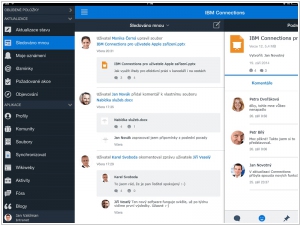Confluence vs HCL Connections
May 20, 2023 | Author: Adam Levine
29
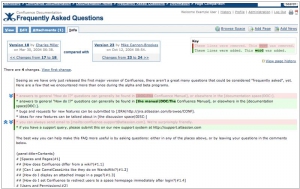
Confluence provides one place for technical teams to collaborate—create, share, and discuss your ideas, files, minutes, specs, mockups, diagrams, and projects. A rich editor, deep Office and JIRA integration, and powerful plugins help teams collaboratively develop technical docs, intranets, and knowledge bases.
Confluence and HCL Connections are both collaboration platforms, but they differ in their features, capabilities, and target audiences. Confluence, developed by Atlassian, is a popular team collaboration tool that focuses on creating, organizing, and sharing content within teams. It offers features like document collaboration, knowledge base creation, project tracking, and team communication. Confluence is known for its simplicity and integration with other Atlassian products like Jira and Trello, making it a preferred choice for agile teams and software development projects. On the other hand, HCL Connections is an enterprise social networking platform that emphasizes social collaboration, knowledge sharing, and employee engagement. It offers features like file sharing, discussion forums, blogs, and employee profiles. HCL Connections is designed for large organizations that require a robust social collaboration platform to foster teamwork and knowledge exchange.
See also: Top 10 Enterprise Social Software
See also: Top 10 Enterprise Social Software
Confluence vs HCL Connections in our news:
2023. Atlassian brings an AI assistant to Jira and Confluence
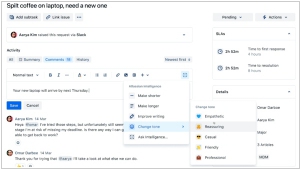
Atlassian has introduced Atlassian Intelligence, an AI-powered 'virtual teammate' that utilizes the company's proprietary models and OpenAI's large language models to create customized teamwork graphs. This technology enables various functionalities, such as AI-generated summaries in Confluence and test plans in Jira Software, as well as the rewriting of responses to customers in Jira Service Management. Atlassian Intelligence provides users with a chatbox similar to Chat-GPT, which is deeply integrated into different products and allows for the referencing of specific documents. For instance, to generate a summary of action items from a recent meeting, users can link the document with the transcript and request the summary inside Confluence. The tool then generates a list of decisions and action items from the meeting.
2021. Atlassian peps up Confluence with new graphical design features
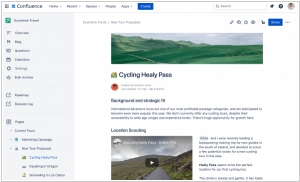
Confluence, the collaborative workspace developed by Atlassian, has been a staple knowledge-sharing tool for over 15 years, widely adopted by companies for its versatility. In its latest update, Confluence introduces several new features to enhance user experience. Users can now customize their spaces with cover images, title emojis, and personalized avatars that represent different sections of Confluence. The addition of smart links allows for seamless integration with platforms like YouTube and Trello, automatically recognizing and displaying links in their native formats. Furthermore, users can schedule the publication of new pages and convert pages into blog posts, reflecting the increasing popularity of corporate blogging within organizations, particularly for internal audiences during the pandemic.
2020. Atlassian’s Confluence gets a new template gallery
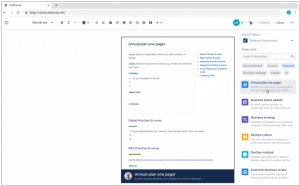
Confluence, the content-centric collaboration tool by Atlassian, is simplifying the onboarding process for new users through the introduction of an enhanced template gallery, featuring 75 additional templates. This update signifies the evolution of Confluence from a specialized wiki primarily used by technical documentation teams to a widely adopted tool utilized across various organizations. The revamped template gallery offers improved search tools, filters, and previews conveniently located in the right-hand panel of your Confluence site. These enhancements facilitate the seamless discovery of templates that are most relevant to your business needs.
2014. Atlassian launches JIRA and Confluence for large companies
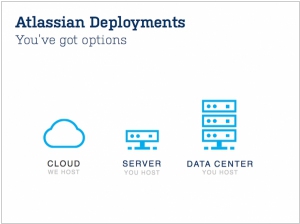
Atlassian has unveiled two new products designed specifically for large enterprises. In the upcoming week, Atlassian will release JIRA Data Center, a version of its project management software that supports running the service on multiple nodes. Additionally, later this summer, it will introduce Confluence Data Center, a collaboration service centered around wikis. With the Data Center versions, larger companies will enjoy improved support for scaling the services across multiple nodes, resulting in enhanced performance and scalability. Administrators will have the ability to route specific applications, teams, or geographies to designated nodes within a cluster, while additional nodes can be added in real time. The clustering technology and shared file systems are seamlessly integrated with industry-standard technologies, ensuring smooth operations.
2013. IBM kills Lotus. Microsoft kills SharePoint
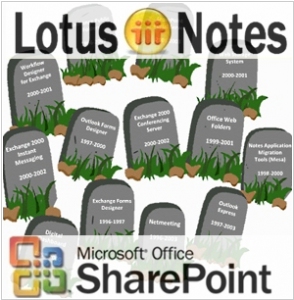
Perhaps the two most famous brands in the history of enterprise software, Lotus and SharePoint, will soon disappear. We mean brands, not specific products. Because by renaming their products, vendors try to erase the association with outdated technologies in customer brain. For example, Lotus appeared back in the 80-s years of last century. In 1995 IBM acquired Lotus Development and began selling their products Lotus Notes/Domino. In the following years most IBM collaboration systems moved under the Lotus umbrella. But last year the revolution occurred. The last child of the Lotus family - SaaS suite LotusLive was renamed to SmartCloud for Social Business. And then the name Lotus was removed from other products. The final nail was the recent launch of Notes/Domino 9.0 Social Edition (without Lotus). ***
2013. IBM embed Email into Connections to drive users out of Email
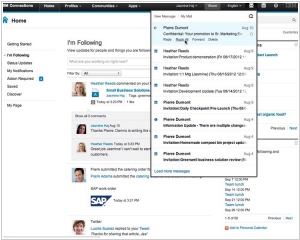
For quite some time, collaboration vendors have been attempting to steer users away from relying on email. They aim to convince us that sharing files and information through alternative means is more convenient than traditional email communication. However, users are reluctant to abandon a technology that has proven its effectiveness over many years, with the inbox remaining the primary workspace for most information workers. Nevertheless, IBM has devised a novel approach to encourage people to transition from email to social tools by integrating email functionality into their social intranet, IBM Connections. Now, users can access emails, contacts, and calendars (stored in either Lotus Domino or Microsoft Exchange mail servers) directly within the Connections interface. This integration offers users the flexibility to choose between sharing content or sending an email, all without needing to switch between applications. Furthermore, if a user opts to "send an email," they can select files from the IBM Connections Files storage. In such cases, the system doesn't attach files to the email; instead, it inserts links to the message and automatically shares the files with the recipients. Clearly, IBM's intention is to position Connections as the central hub within its collaboration suite, much like Microsoft's SharePoint in their suite. In fact, IBM's suite is aptly named IBM SmartCloud for Social Business, emphasizing the importance of the "social" aspect in their comprehensive offering.
2012. IBM LotusLive becomes SmartCloud for Social Business
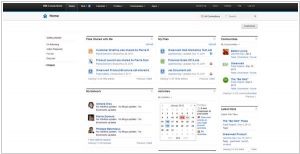
IBM's SaaS collaboration services under the LotusLive umbrella received a lot of good reviews and always presented in the analyst top product lists. Nevertheless they haven't been very successful in sales (compared to the competitors). "What's the problem?" - IBMers tried to figure out - "Maybe the problem in the name? Or in marketing?". And they decided to copy the model of Salesforce and to see what will happen. They decided to remove the word "Lotus", which many people associate with the heavy software from the past. And instead, wherever it's possible, they put the words "Cloud" and especially "Social". In result, LotusLive becomes SmartCloud for Social Business. In its description you'll find such words as Social, Social and Social. And on the US television the new SmartCloud cartoon commercial (reminding Salesforce Chatter ads) has appeared (watch the video). ***
2011. JIRA, Confluence available as SaaS services
Atlassian has launched the new SaaS service Atlassian OnDemand, which includes its popular tools for managing software development projects: JIRA (issue-tracker), Confluence (wiki), GreenHopper (Agile Project Management), Bonfire (bug reporter), FishEye (code manager), Crucible (code review) and Bamboo (integration). All products in the SaaS version provide the full functionality of the installable counterparts. There are only minimal restrictions on the tool integration and use of the custom plug-ins. You can turn on/off the tools as needed. The service pricing is traditional for Atlassian - "everything for $10 for 10 users." Recall that the company is also selling the 10-user leniences of the same installable products for $10. So you can either buy the product for $10, or rent it for $10/month. ***
2010. Lotus Connections 3.0 gets social recommendations
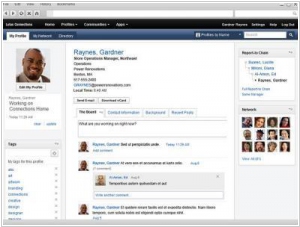
Enterprise social software developers continue to copy Facebook features. The new version of IBM's enterprise social networking software Lotus Connections 3.0 features widgets with social recommendations. First is a list of "recommended friends," that user sees when logging into Lotus Connections. The fact is that Lotus Connections also includes "friends" feature - social connections. You become a "friend" when subscribe to collegue updates (microblog). So now, basing on your existing friends, your interests and expertise and your previous actions - the system provides a list of users that you are interested in "making friends" with. Besides, when visiting other user profiles, you now can see the social path that links you to this person and things that you have in common (such as a list of the communities that both belong to). And on the communities page you can see the widget with a list communities that you might be interested in. ***
2009. IBM unveils LotusLive Connections
IBM has introduced LotusLive Connections, a software-as-a-service (SAAS) version of its Lotus Connections social networking suite. Initially launched in 2007 as a collaboration suite for businesses aiming to benefit from the popularity of platforms like Facebook, Lotus Connections offers various applications such as employee profiles, blogging, bookmarks, and community features. Building upon the success of LotusLive Engage, IBM's first SAAS social networking and collaboration application released in April, LotusLive Connections represents a departure from the traditional approach of using hosted software. Right from the start, users of LotusLive Connections can take advantage of the Connections Activities app, which facilitates file sharing and instant messaging conversations.

